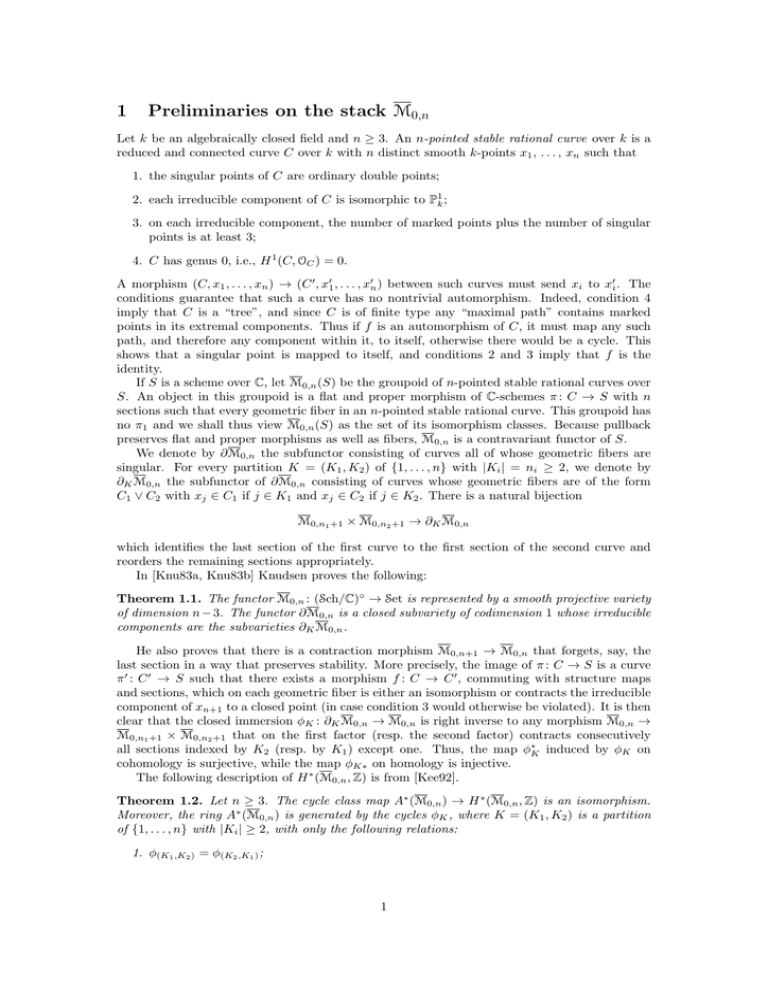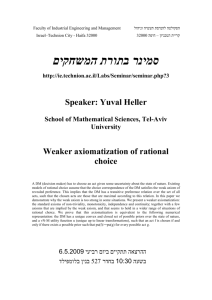M 1 Preliminaries on the stack
advertisement

1
Preliminaries on the stack M0,n
Let k be an algebraically closed field and n ≥ 3. An n-pointed stable rational curve over k is a
reduced and connected curve C over k with n distinct smooth k-points x1 , . . . , xn such that
1. the singular points of C are ordinary double points;
2. each irreducible component of C is isomorphic to P1k ;
3. on each irreducible component, the number of marked points plus the number of singular
points is at least 3;
4. C has genus 0, i.e., H 1 (C, OC ) = 0.
A morphism (C, x1 , . . . , xn ) → (C 0 , x01 , . . . , x0n ) between such curves must send xi to x0i . The
conditions guarantee that such a curve has no nontrivial automorphism. Indeed, condition 4
imply that C is a “tree”, and since C is of finite type any “maximal path” contains marked
points in its extremal components. Thus if f is an automorphism of C, it must map any such
path, and therefore any component within it, to itself, otherwise there would be a cycle. This
shows that a singular point is mapped to itself, and conditions 2 and 3 imply that f is the
identity.
If S is a scheme over C, let M0,n (S) be the groupoid of n-pointed stable rational curves over
S. An object in this groupoid is a flat and proper morphism of C-schemes π : C → S with n
sections such that every geometric fiber in an n-pointed stable rational curve. This groupoid has
no π1 and we shall thus view M0,n (S) as the set of its isomorphism classes. Because pullback
preserves flat and proper morphisms as well as fibers, M0,n is a contravariant functor of S.
We denote by ∂M0,n the subfunctor consisting of curves all of whose geometric fibers are
singular. For every partition K = (K1 , K2 ) of {1, . . . , n} with |Ki | = ni ≥ 2, we denote by
∂K M0,n the subfunctor of ∂M0,n consisting of curves whose geometric fibers are of the form
C1 ∨ C2 with xj ∈ C1 if j ∈ K1 and xj ∈ C2 if j ∈ K2 . There is a natural bijection
M0,n1 +1 × M0,n2 +1 → ∂K M0,n
which identifies the last section of the first curve to the first section of the second curve and
reorders the remaining sections appropriately.
In [Knu83a, Knu83b] Knudsen proves the following:
Theorem 1.1. The functor M0,n : (Sch/C)◦ → Set is represented by a smooth projective variety
of dimension n − 3. The functor ∂M0,n is a closed subvariety of codimension 1 whose irreducible
components are the subvarieties ∂K M0,n .
He also proves that there is a contraction morphism M0,n+1 → M0,n that forgets, say, the
last section in a way that preserves stability. More precisely, the image of π : C → S is a curve
π 0 : C 0 → S such that there exists a morphism f : C → C 0 , commuting with structure maps
and sections, which on each geometric fiber is either an isomorphism or contracts the irreducible
component of xn+1 to a closed point (in case condition 3 would otherwise be violated). It is then
clear that the closed immersion φK : ∂K M0,n → M0,n is right inverse to any morphism M0,n →
M0,n1 +1 × M0,n2 +1 that on the first factor (resp. the second factor) contracts consecutively
all sections indexed by K2 (resp. by K1 ) except one. Thus, the map φ∗K induced by φK on
cohomology is surjective, while the map φK∗ on homology is injective.
The following description of H ∗ (M0,n , Z) is from [Kee92].
Theorem 1.2. Let n ≥ 3. The cycle class map A∗ (M0,n ) → H ∗ (M0,n , Z) is an isomorphism.
Moreover, the ring A∗ (M0,n ) is generated by the cycles φK , where K = (K1 , K2 ) is a partition
of {1, . . . , n} with |Ki | ≥ 2, with only the following relations:
1. φ(K1 ,K2 ) = φ(K2 ,K1 ) ;
1
2. for any pairwise distinct indices i, j, k, l in {1, . . . , n},
X
X
X
φK =
φK =
φK ;
i,j∈K1
k,l∈K2
i,k∈K1
j,l∈K2
(1)
i,l∈K1
j,k∈K2
3. φK φL = 0 unless Ki ⊆ Lj for some i, j ∈ {1, 2}.
We denote by δK ∈ H 2 (M0,n , Z) the image of the prime divisor φK by the cycle class map.
2
Axioms for genus 0 Gromov–Witten invariants
Let V be a smooth projective variety over C of complex dimension d. A tree level system of
Gromov–Witten classes for V is a family of Q-linear maps
V
I0,n,β
: H ∗ (V, Q)⊗n → H ∗ (M0,n , Q),
defined for all n ≥ 3 and all homology classes β ∈ H2 (V, Z), required to satisfy the following
axioms. (From now on, cohomology is understood to have rational coefficients.)
V
Effectivity axiom. I0,n,β
= 0 unless β is is effective, i.e., has nonnegative intersection number
with the image of any ample line bundle in H 2 (V, Z), or equivalently, has nonnegative degree in
any projective embedding.
V
Σn -invariance axiom. I0,n,β
is Σn -equivariant (Σn acts on H ∗ (V, Q)⊗n with the Koszul sign
convention and on M0,n by permuting marked points).
V
Dimension axiom. I0,n,β
is a graded map of degree 2hKV , βi − 2d, where KV = c1 (Ω∧d
V ) ∈
2
H (V, Z) is the canonical class of V .
Identity axiom. If n ≥ 4,
V
V
I0,n,β
(γ1 ⊗ · · · ⊗ γn−1 ⊗ e) = πn∗ I0,n−1,β
(γ1 ⊗ · · · ⊗ γn−1 ),
where πn : M0,n → M0,n−1 forgets the nth marked point.
For n = 3 and β 6= 0,
V
I0,3,β
(γ1 ⊗ γ2 ⊗ e) = 0.
Divisor axiom. If n ≥ 4 and δ ∈ H 2 (V, Q),
V
V
πn∗ I0,n,β
(γ1 ⊗ · · · ⊗ γn−1 ⊗ δ) = hδ, βiI0,n−1,β
(γ1 ⊗ · · · ⊗ γn−1 ).
Mapping to point axiom.
V
I0,n,0
(γ1
( R
⊗ · · · ⊗ γn ) =
V
γ1 ∧ · · · ∧ γn e
0
Pn
if i=1 |γi | = 2d,
otherwise.
Splitting axiom. Let K = (K1 , K2 ) be a partition of {1, . . . , n}, with |Ki | = ni ≥ 2. Then
X
V
V
V
φ∗K I0,n,β
(γ1 ⊗ · · · ⊗ γn ) = ±
(I0,n
⊗ I0,n
)((⊗j∈K1 γj ) ⊗ ∆ ⊗ (⊗j∈K2 γj )),
1 +1,β1
2 +1,β2
β=β1 +β2
where ∆ ∈ H ∗ (V, Q)⊗2 is the image of the diagonal cycle and the sign is the Koszul sign arising
from moving the K1 - and K2 -indexed classes past one another. The effectivity axiom guarantees
that the sum on the right-hand side is essentially finite.
V
Motivic axiom. The map I0,n,β
comes from a morphism of Chow motives V n → M0,n (2d −
2hKV , βi). This axiom is not used in the next section.
2
3
The first reconstruction theorem
The results of this section are from [KM94].
The codimension of a nonzero homogeneous class α ∈ H ∗ (M0,n ) is 2n − 6 − |α|, where
α ∈ H |α| (M0,n ).
Proposition 3.1. Any tree level system of GW classes is determined by its classes of codimenV
sion zero. In fact, a homogeneous class I0,n,β
(γ1 ⊗· · ·⊗γn ) of positive codimension is determined
by codimension zero classes with at most n − 1 arguments.
Proof. Assume classes of codimension zero are known. We compute an arbitrary homogeneous
V
class α = I0,n,β
(γ1 ⊗ · · · ⊗ γn ) by induction on n ≥ 3. If n = 3, since M0,3 is zero-dimensional,
the class is either zero or of codimension zero.
Let n ≥ 4. For every partition K = (K1 , K2 ) of {1, . . . , n} with |Ki | = ni ≥ 2, the splitting
axiom expresses φ∗K α in terms of GW classes with a strictly smaller n (since ni + 1 < n), so it
is known by induction hypothesis. Consider the exact sequence
M
\
H ∗ (M0,n1 +1 ) ⊗Q H ∗ (M0,n2 +1 ),
0→
ker(φ∗K ) → H ∗ (M0,n ) →
K
K
φ∗K ,
in which the last arrow is sum of the
and suppose that we can prove
\
ker(φ∗K ) = H 2n−6 (M0,n ).
(2)
K
Then, since α is homogeneous, it either has codimension zero or is determined by all the φ∗K α.
The inclusion from right to left in (2) is clear because the dimension of M0,n1 +1 × M0,n2 +1
is one less than the dimension of M0,n . Conversely, consider a homogeneous class α ∈ H i (M0,n )
with φ∗K α = 0 for all K. Thus α ∧ δK = φK∗ φ∗K α = 0 for all K, and so α ∧ η = 0 for every
homogeneous class η with |η| > 0 (any such class being a rational polynomial in the δK ’s with
i
2n−6−i
no constant
(M0,n ) → Q,
R term, by Theorem 1.2). Since the pairings H (M0,n ) ⊗Q H
α ⊗ η 7→ α ∧ η, are perfect, either α = 0 or i = 2n − 6.
Theorem 3.2 (First Reconstruction Theorem). Suppose that H ∗ (V ) is generated as a ring
by H 2 (V ). Then any tree level system of GW classes is determined by its classes of the form
V
I0,3,β
(γ1 ⊗ γ2 ⊗ γ3 ) with mini |γi | = 2.
Let B ⊂ H2 (V, Z) denote the monoid of effective classes. We endow the set of triples (n, β, k)
with n ≥ 3, β ∈ B, and k ≥ 0 with the lexicographic order: (n, β, k) ≤ (n0 , β 0 , k 0 ) if n < n0 , or if
n = n0 and β < β 0 (which means that β = β 0 + β 00 for some β 00 ∈ B − {0}), or if n = n0 , β = β 0 ,
and k ≤ k 0 . The monoid B is obviously torsion-free and it is finitely generated because B ⊗Z Q
is a cone in the finite-dimensional vector space H2 (V, Q). It follows that this partial order is
well-founded, and we are therefore entitled to reason by induction with respect to it.
In addition to the classes in the statement of the theorem, we can therefore assume that the
V
0
0
0
0
0
classes I0,n
0 ,β 0 (γ1 ⊗ · · · ⊗ γn0 ) are known for all (n , β , mini |γi |) < (n, β, mini |γi |), and we must
V
show that I0,n,β (γ1 ⊗ · · · ⊗ γn ) is uniquely determined by the axioms. By Proposition 3.1, we
V
are already done unless I0,n,β
(γ1 ⊗ · · · ⊗ γn ) has codimension zero, which we assume from now
on. The point of this assumption is that the map πn∗ : H 2n−6 (M0,n ) → H 2(n−1)−6 (M0,n−1 )
appearing in the divisor axiom is an isomorphism.
If β = 0, the class is determined by the mapping to point axiom. If n ≥ 4 and mini |γi | is
0 (resp. 2), it is determined by the identity axiom (resp. the divisor axiom and the fact that it
has codimension zero), Σn -invariance, and the induction hypothesis. If n = 3 and mini |γi | is 0
(resp. 2), it is determined by the identity axiom and Σn -invariance (resp. by assumption).
Assume therefore that β > 0 and mini |γi | > 2. By reordering the arguments, we can assume
that |γn | = mini |γi |. Since H ∗ (V ) is generated by H 2 (V ), we can further assume that γn = δ ∧ where |δ| = 2 and || ≥ 2.
3
V
Lemma 3.3. Let i, j, k, l be four distinct indices in {1, . . . , n}, n ≥ 4, and let I0,n,β
(γ1 ⊗· · ·⊗γn )
be a GW class. Then for appropriate signs, the class
V
V
± φi,j∗ (e ⊗ I0,n−1,β
(γi ∧ γj ⊗ (⊗t6=i,j γt ))) ± φk,l∗ (e ⊗ I0,n−1,β
(γk ∧ γl ⊗ (⊗t6=k,l γt )))
V
V
± φi,k∗ (e ⊗ I0,n−1,β
(γi ∧ γk ⊗ (⊗t6=i,k γt ))) ± φj,l∗ (e ⊗ I0,n−1,β
(γj ∧ γl ⊗ (⊗t6=j,l γt )))
is determined by GW classes of lower order. Here φi,j : M0,3 × M0,n−1 → M0,n is the divisor
for the partition (K1 , K2 ) with K1 = {i, j}, and e ∈ H ∗ (M0,3 , Q) is the ring unit.
Proof. We use the relations (1):
X
X
V
V
φK∗ φ∗K I0,n,β
(γ1 ⊗ · · · ⊗ γn ) =
φK∗ φ∗K I0,n,β
(γ1 ⊗ · · · ⊗ γn ).
i,j∈K1
k,l∈K2
i,k∈K1
j,l∈K2
By the splitting axiom, this becomes
X
X
V
V
±φK∗ (I0,n
⊗ I0,n
)((⊗m∈K1 γm ) ⊗ ∆ ⊗ (⊗m∈K2 γm ))
1 +1,β1
2 +1,β2
i,j∈K1 β=β1 +β2
k,l∈K2
=
X
X
V
V
±φK∗ (I0,n
⊗ I0,n
)((⊗m∈K1 γm ) ⊗ ∆ ⊗ (⊗m∈K2 γm )).
1 +1,β1
2 +1,β2
i,k∈K1 β=β1 +β2
j,l∈K2
All nonzero terms only involve classes of order strictly less than (n − 1, β), except those terms
in which n1 = 2 and β1 = 0, or n2 = 2 and β2 = 0. There are two such terms on each side of
the equality. Let’s look at the term on the left-hand side indexed by K1 = {i, j}:
V
V
±φi,j∗ (I0,3,0
⊗ I0,n−1,β
)(γi ⊗ γj ⊗ ∆ ⊗ (⊗m6=i,j γm ))
(the order
of γi and γj only affects the sign,Ras the following computation shows). If we write
P
V
∆ = a αa ⊗ βa , then I0,3,0
(γi ⊗ γj ⊗ αa ) = ( V γi ∧ γj ∧ αa )e by the mapping to point axiom (if
the integrand is not a top class, let the integral be zero). Poincaré duality and the computation
Z
Z
Z
X Z Z
γ ∧ αa βa ∧ γ 0 =
p∗1 (γ) ∧ p∗2 (γ 0 ) ∧ ∆ =
p∗1 (γ) ∧ p∗2 (γ 0 ) =
γ ∧ γ0
a
V
V
V ×V
∆(V )
V
P R
show that for any cohomology class γ, a ( V γ ∧ αa )βa = γ. Thus,
V
V
V
±(I0,3,0
⊗ I0,n−1,β
)(γi ⊗ γj ⊗ ∆ ⊗ (⊗m6=i,j γm )) = ±e ⊗ I0,n−1,β
(γi ∧ γj ⊗ (⊗m6=i,j γm )).
A similar computation puts the other three terms in the desired form.
The lemma applied to the indices 1, 2, n, n + 1 ∈ {1, . . . , n + 1} and the induction hypothesis
show that the expression
V
± (φ1,2 )∗ (e ⊗ I0,n,β
(γ1 ∧ γ2 ⊗ γ3 ⊗ · · · ⊗ γn−1 ⊗ δ ⊗ ))
V
± (φn,n+1 )∗ (e ⊗ I0,n,β
(δ ∧ ⊗ γ1 ⊗ · · · ⊗ γn−1 ))
V
± (φ1,n )∗ (e ⊗ I0,n,β
(γ1 ∧ δ ⊗ γ2 ⊗ · · · ⊗ γn−1 ⊗ ))
V
± (φ2,n+1 )∗ (e ⊗ I0,n,β
(γ2 ∧ ⊗ γ1 ⊗ γ3 ⊗ · · · ⊗ γn−1 ⊗ δ))
V
is uniquely determined. Since φK∗ is injective, the second term determines I0,n,β
(γ1 ⊗ · · · ⊗ γn ).
But the other three terms are also determined by induction hypothesis, since |δ| < mini |γi | and
|| < mini |γi |. This completes the proof of Theorem 3.2.
Further restrictions on the classes of Theorem 3.2 are obtained by noting that the class
V
(γ1 ⊗ γ2 ⊗ γ3 ) can be nonzero only if
I0,3,β
|γ1 | + |γ2 | + |γ3 | = 2d − 2hKV , βi,
by the dimension axiom. Since |γi | ≤ 2d and mini |γi | = 2, it will therefore vanish unless β
satisfies
−d − 1 ≤ hKV , βi ≤ d − 3.
If (and only if) kerhKV , −i ∩ B = 0, there are only finitely many such effective β.
4
References
[KM94]
Maxim Kontsevich and Yuri Manin, Gromov–Witten classes, quantum cohomology,
and enumerative geometry, Comm. Math. Phys. 164 (1994), no. 3, pp. 525–562
[Kee92]
Sean Keel, Intersection theory of moduli spaces of stable n-pointed curves of genus
zero, Trans. AMS 330 (1992), pp. 545–574
[Knu83a] Finn F. Knudsen, The projectivity of the moduli space of stable curves, II, Math.
Scand. 52 (1983), pp. 161–199
[Knu83b]
, The projectivity of the moduli space of stable curves, III, Math. Scand. 52
(1983), pp. 200–212
5







